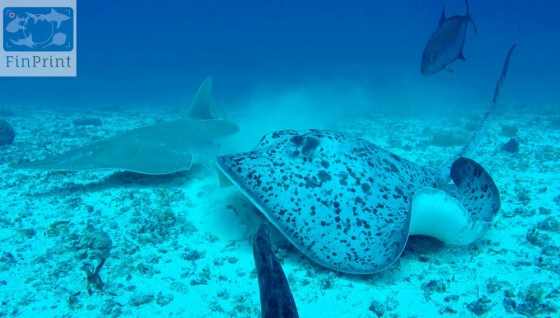Where
Who
Conrad Speed (AIMS and Global FinPrint), Mike Cappo (AIMS), and Mark Meekan (AIMS and Global FinPrint)
When
Repeat surveys in 2004 and 2016.
Why
Sharks play an important role in tropical ecosystems. The presence of sharks has been shown to affect the diet, condition, and morphology of their prey, as well as the structure of the food chain, and there is also evidence that suggests the absence of predators such as sharks may affect the ability of reefs to recover from disturbances that remove coral cover. An early survey at Ashmore Reef in 2004 found low numbers of reef sharks, and evidence of high illegal fishing pressure, particularly in 2005–2006. To curb illegal activity, including illegal fishing, in the region, a Border Force vessel was deployed to at Ashmore Reef on a near-permanent basis from 2008 onward. In order to assess whether these changes in enforcement had an effect on shark communities, the Ashmore Reef shark populations were re-surveyed in 2016 as part of the Global FinPrint Project.
How
Surveys were conducted using mono–baited remote underwater video stations (BRUVS). These consisted of a lightweight aluminium frame, GoPro, and a bait arm and bag. The special lightweight rigs were constructed for this project and they allowed manual deployment and retrieval of BRUVS from tenders to the RV Solander. A total of 46 BRUVS were deployed in 2004 and 89 in 2016 at Ashmore Reef. Additional deployments were also done at Scott Reef North (48) and South (49), and at Imperieuse (18) and Clerke Reefs (39) in the Rowley Shoals Marine Park in 2016.
What did we learn?
There were 4.5 times more grey reef sharks at Ashmore Reef in 2016 compared to 2004, as well as numerous other species that were absent in the initial survey, such as tiger sharks, nurse sharks, and leopard sharks. Grey reef shark numbers increased much faster than anticipated based on existing demographic models, which may have been due to compensatory responses such as reduced predation and competition. The Ashmore Reef shark community now resembles that of the Rowley Shoals, which has not been subject to illegal fishing. This project is one of the only known studies that has found a recovery of reef shark populations.
What next?
The next phase of this project is to analyse fish communities at Ashmore Reef, to assess whether there has been a similar response to the removal of illegal fishing pressure. Additional surveys at Ashmore Reef are also needed to follow the progress of shark community recovery into the future.
Related data and publications
Speed, C.W., Cappo, M., Meekan, M.G. (2018) Evidence for rapid recovery of shark populations within a coral reef marine protected area. Biological Conservation 220, 308-319.
Meekan, M., Cappo, M. (2004) Non-destructive techniques for rapid assessment of shark abundance in Northern Australia, pp. 1-36. Australian Government Department of Agriculture, Fisheries and Forestry, Townsville.
Meekan, M.M., Cappo, M.M., Carleton, J.J., Marriott, R.R. (2006) Surveys of shark and fin-fish abundance on reefs within the MOU74 Box and Rowley Shoals using baited remote underwater video systems. Prepared for the Australian Government Department of the Environment and Heritage.
Global Finprint project website
For more information please contact marinescience@environment.gov.au.



